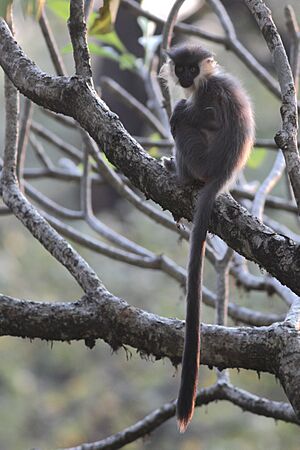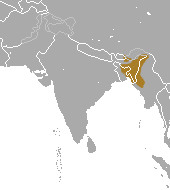Capped langur facts for kids
Quick facts for kids Capped langur |
|
|---|---|
 |
|
| Capped langur in Manas National Park | |
| Conservation status | |
| Scientific classification | |
| Genus: |
Trachypithecus
|
| Species: |
pileatus
|
 |
|
| Capped langur range | |
The capped langur (Trachypithecus pileatus) is a type of primate. It belongs to the monkey family called Cercopithecidae. These langurs live in warm, dry forests. You can find them in northeast India, Bhutan, Bangladesh, and Myanmar.
Capped langurs spend most of their time in trees. They are known for eating many different kinds of plants. In fact, they eat from over 40 different plant species!
Contents
About the Capped Langur
The capped langur got its name because of the special fur on its head. This fur looks like a cap. They are a fascinating species of monkey.
How Scientists Name Them
The capped langur was first described by a scientist named Edward Blyth in 1843. Scientists use a special two-part name for every animal. For the capped langur, this name is Trachypithecus pileatus.
Scientists also recognize different groups within the capped langur species. These are called subspecies. As of 2005, there are four known subspecies:
- T. p. pileatus
- T. p. durga
- T. p. brahma
- T. p. tenebricus
Where Capped Langurs Live
Capped langurs make their homes in several countries in Asia. These include northeast India, Bhutan, Bangladesh, and Myanmar.
Their Forest Homes
They prefer to live in subtropical and tropical dry forests. These forests provide them with plenty of trees. The trees are important for both shelter and food. They spend almost all their time high up in the branches.
What Capped Langurs Eat and Do

Capped langurs are mostly active during the day. They spend a lot of their time looking for food. They are herbivores, meaning they only eat plants.
Their Plant-Based Diet
Studies in Arunachal Pradesh showed that capped langurs spend about 40% of their day eating. Their diet mainly consists of leaves, flowers, and fruits. Leaves make up a big part of what they eat, almost 60% of their diet! They are not picky eaters when it comes to plants. They have been seen eating from as many as 43 different plant species. This varied diet helps them get all the nutrients they need.


